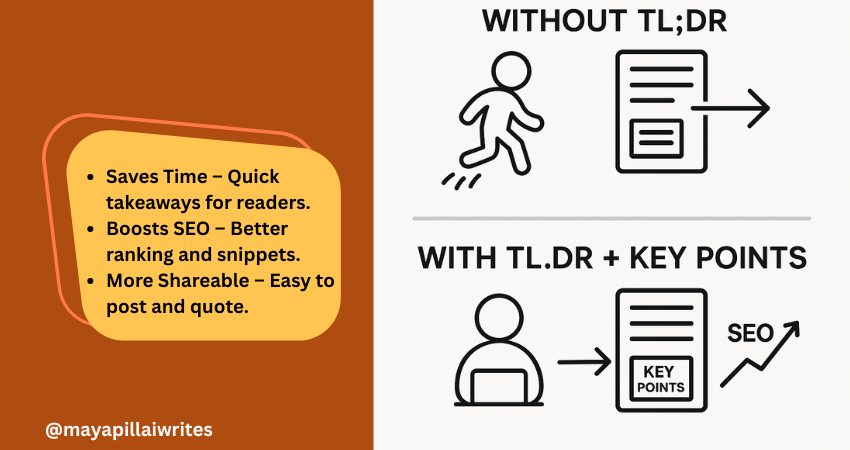Including a TL;DR in content is no longer optional. Readers skim, AI search engines summarize, and attention spans keep shrinking. A TL;DR(Too Long; Didn’t Read) gives a quick summary that respects your readers’ time and makes your blog easier for AI tools and Google’s Search Generative Experience (SGE) to surface. But a TL;DR alone isn’t enough. Adding Key Points beneath it ensures that both skimmers and detail-seekers get value. In an era where AI decides what parts of your content get shown, these two elements can set your blog/article apart.
Table of Contents
Toggle
TL; DR
- A TL;DR in content is a short summary that captures your article’s main idea. It helps readers, AI tools, and search engines understand your blog quickly.
- Key Points expand on the TL;DR with detailed highlights, giving both readers and AI more context.
- Using both together improves readability, SEO performance, AI search visibility, and builds trust with your audience.
Key Takeaways
A TL;DR isn’t just a convenience — it’s a strategic tool that improves both user experience and how AI-driven search engines interpret your content.
Key Points aren’t filler; they strengthen SEO by adding structure, making your blog more likely to rank for related queries and appear in featured snippets.
Pairing TL;DR and Key Points bridges the gap between human readers and AI systems, ensuring content is engaging, scannable, and machine-readable at the same time.
In long-form blogs, Key Points can double as jump links for better navigation, which is especially important for mobile readers.
Respecting reader time with a TL;DR and guiding them with Key Points ultimately builds trust and authority, which pays off in both engagement and search rankings.
What is TL;DR in Content?
TL;DR is a short summary that captures the core message of your article. Usually placed right after the introduction, it helps readers and AI tools quickly understand what the content is about.
Why it’s important now:
- Readers want speed
Most online readers don’t have the patience to go through long paragraphs before deciding if something is worth their time. A TL;DR gives them the headline takeaways immediately, allowing them to judge whether to continue reading. Without it, you risk losing them before they get to your key message. - AI favors clarity
Search engines and AI-powered tools are built to pick up well-structured summaries. A TL;DR written in simple, direct language makes it easier for these systems to surface your blog in snippets, SGE cards, and chat-based search results. This increases your visibility without extra effort. - Boosts visibility
Blogs with a TL;DR have a higher chance of being featured in “People Also Ask” boxes or summary snippets. Search engines look for clear, condensed content they can repurpose quickly, and a TL;DR is ready-made for that. - Improves shareability
Readers who find value in your TL;DR are more likely to copy it into a LinkedIn post, share it in a newsletter, or use it as a quote in their own content. This creates organic backlinks and visibility for your blog. - Voice search ready
Voice assistants like Alexa and Google Assistant prefer short, straightforward answers. A TL;DR formatted in 2–3 sentences naturally fits the length of a spoken response, which makes your blog more discoverable in voice search results. - Mobile-first reading
On small screens, people scroll faster and often skim through headlines only. Having a TL;DR upfront ensures your blog’s value is captured in the first screen view, even if the reader doesn’t scroll further. - Trust-building
By offering a summary upfront, you show readers you respect their time. It also signals confidence in your content — you’re not hiding the main message in walls of text. This creates trust and makes readers more likely to return to your blog. - Supports accessibility
Not all readers consume content the same way. For people with attention difficulties or those using screen readers, a TL;DR provides a simple entry point that ensures they still get value from your writing.
What are Key Points?
Key Points are a set of bulleted highlights that expand slightly beyond a TL;DR. While TL;DR gives the big picture, Key Points provide a roadmap of what’s inside the article.
Why they’re valuable in the AI era:
- Act as signposts
Many readers jump around instead of reading blogs linearly. Key Points act like a table of contents in miniature, showing readers what the article covers. This keeps them on your page longer because they know exactly what to expect. - Strengthen SEO
Search engines like Google prioritize structured content. Bullet lists with concise explanations often show up in featured snippets and “zero-click” results. By using Key Points, you give your blog multiple chances to rank for related queries, even if the reader never clicks through. - Support AI summaries
AI-driven platforms, including Google SGE, scan content for structured data they can repurpose. Well-written Key Points make it easier for these systems to understand your blog’s scope and deliver accurate summaries, increasing your chances of being displayed in answer cards. - Increase retention
When readers see clear Key Points, they know the content is organized. This makes them more likely to stay on your blog and read further. A messy block of text, in contrast, often leads to higher bounce rates. - Add clarity for busy readers
Some people want more than a one-line TL;DR but don’t have time for the full article. Key Points give them the middle ground: detailed highlights that still save time. It’s a way of serving both casual readers and more serious ones at the same time. - Improve content navigation
In long-form blogs, Key Points can be turned into clickable jump links. This is especially helpful for mobile readers, who don’t want to keep scrolling endlessly to find one section. It improves usability and keeps them engaged. - Build authority
Presenting your highlights clearly at the start shows confidence in your insights. It signals that you know your subject well enough to extract the main lessons upfront, which builds trust with both human readers and AI tools.
TL;DR vs Key Points: Why You Need Both
You might wonder, “If I already have a TL;DR, do I still need Key Points?” The short answer is yes. They serve different roles, and together they create a complete reading experience.
- TL;DR → Works as a quick digest for skimmers, AI tools, and voice search. It’s the high-level summary.
- Key Points → Provide a structured breakdown for readers who want more detail and for AI engines that need context.
Together, they:
- Make your blog accessible to multiple types of readers — skimmers, busy professionals, and deep readers.
- Increase your chances of being picked up in featured snippets, SGE cards, and voice search answers.
- Improve engagement and reduce bounce rates because readers can choose how they consume your content.
Think of TL;DR as the headline summary and Key Points as the chapter guide. Both are essential in today’s fast-paced, AI-driven search world.
Best Practices for Using TL;DR and Key Points
- Place the TL;DR right after your opening paragraph so it’s visible before readers lose interest.
- Keep the TL;DR short — three to four sentences or bullets that capture the main idea without details.
- Add Key Points immediately below the TL;DR to provide a structured snapshot.
- Write Key Points in complete, meaningful sentences so they stand on their own.
- Refresh both sections when you update your content for SEO, ensuring they match the latest version.
- For long articles, turn Key Points into clickable jump links that improve navigation.
To Sum Up
In the AI-driven search era, TL;DR and Key Points are more than just formatting tricks. They make your blog readable for humans and optimized for machines. Readers get quick answers, AI gets structured clarity, and you get better visibility in search results. If you want your content to perform better and stay future-ready, start treating TL;DR in content and Key Points as essential, not optional.
Quick FAQs
- Q1. What is TL;DR in content?
TL;DR means “Too Long; Didn’t Read.” It’s a short summary that gives the main idea of your blog in just a few sentences. - Q2. Why should I add a TL;DR to my blog?
A TL;DR helps readers get the gist fast, keeps them engaged, and improves your chances of showing up in snippets and AI search results. - Q3. What are Key Points in a blog?
Key Points are a list of highlights that show the most important parts of your content. They act like a mini roadmap for readers and search engines. - Q4. Do I need Key Points if I already have a TL;DR?
Yes. A TL;DR is a quick summary, while Key Points give more detail. Together, they help both skimmers and deep readers. - Q5. How do TL;DR and Key Points help SEO?
They make your content scannable, reduce bounce rates, and increase the chance of your blog appearing in Google snippets or AI answer cards. - Q6. Where should I place the TL;DR in my article?
The TL;DR works best right after your introduction so readers and search engines see it upfront.
